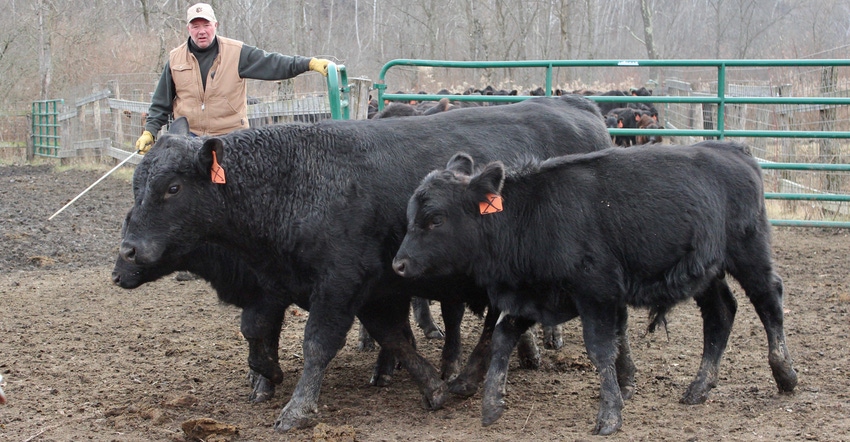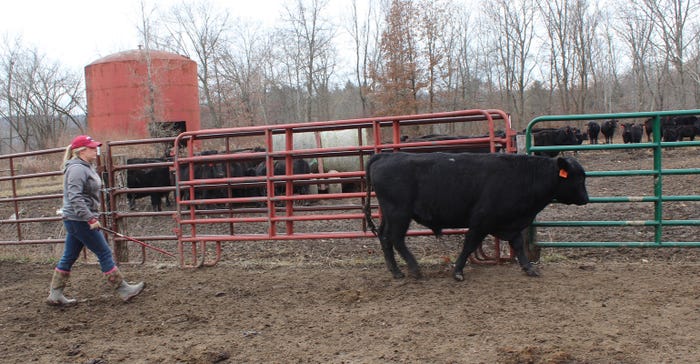
The view to the east from James Coffelt’s ranch house shows few signs of human influence, with rolling grasslands, tree-covered ravines and a sparkling pond. In reality, though, the landscape was once reshaped by strip mining and then restored as rangeland. Land like this in eastern Ohio has an economic advantage over ranchland in the western part of the country, Coffelt says. Even though the land in Ohio tends be more expensive, the carrying capacity is greater, so higher cattle stocking rates can provide better profitability.
“Very few people appreciate the potential for ranching in this part of the county,” he says.
Coffelt’s ranch, the Ohio Land and Cattle Company, covers 8,000 acres in Harrison County, near Cadiz. He originally bought land in the area 15 years ago to use for hunting, and then got a few cows. Five years later, the land value had doubled, so he sold the original tract and bought a larger parcel nearby. Since then he has purchased additional land as it has become available and has built his beef herd to 1,000 head.
He has developed management strategies that run contrary to those used by many other Ohio cattle operations.
Better breeding
Coffelt started out raising registered Black Angus, and has appreciated the breed association’s excellent pedigree records and accessible Expected Progeny Differences information. For his breeding program, he is most interested in expected birth weights, weaning weights, milk production and cow energy value. He selects for animals that have lower birth weights, moderate growth, moderate milk production and low maintenance requirements. The lower birth rates come from slightly shorter gestations, he explains. Rather than nine months and one week, gestation might be just nine months. That reduces the chances of calving difficulties. He prefers moderate growth and milk production along with low maintenance requirements for efficient production on year-around pasture. The cows that perform best tend to be small and thick, weighing 1,100 to 1,200 pounds, he explains. He culls any that remain open, calve late, need assistance with calving or have trouble wintering on pasture. He also culls based on disposition: “If anything gets aggressive, it’s gone.”
 CALM MANAGEMENT: Carmen Everett, who helps manage the beef herd at the Ohio Land and Cattle Company, uses quiet handling to keep cattle calm during sorting.
CALM MANAGEMENT: Carmen Everett, who helps manage the beef herd at the Ohio Land and Cattle Company, uses quiet handling to keep cattle calm during sorting.

To take advantage of the flush of pasture growth in the spring, Coffelt breeds for May and June calving with a 60-day calving window. That gives cows fresh pasture when their energy needs are highest, just before and after calving. “That’s calving in sync with nature,” Coffelt explains.
During calving, the ranch staff tags and weighs calves just after birth, using a tough bathroom scale they haul to the pasture on a four-wheeler. At weaning, they weigh calves again and give them permanent ear tags. For most cows in the herd, those two encounters will be the only times they have direct human contact until they are sold. “We may never touch that cow again,” Coffelt says. Even so, the herd is calm around people.
Besides breeding for calm dispositions, Coffelt and his ranch staff avoid loud, rough treatment of animals. One day last fall, for instance, he and his daughter, Carmen Everett, and brother-in-law, Jamie Butler, sorted out steer calves for sale. They quietly eased animals from pen to pen, moving just close enough with sorting poles and paddles to get the cattle moving in the right direction. Such careful handling minimizes panicked reactions from the cattle.
Diverse markets
Coffelt has developed several market outlets for his cattle. He keeps the best bull calves intact to serve as herd sires, or to sell. He also leases his herd bulls to other beef producers for a few months at a time. Since he breeds for May or June calving, he doesn’t need his bulls at the same time as cattlemen who breed for calving in March or in the fall, he explains. “I can lease a bull to someone who calves earlier and then lease it again to someone who calves later.”
Steer calves have the lowest profit potential and are sold off the ranch as feeder calves. “We can’t get them out of here fast enough,” says Coffelt.
 WELL MANNERED: Jamie Butler, who helps manage the beef herd at the Ohio Land and Cattle Company, watches for signs of aggression from cows and bulls so dangerous animals can be removed from the herd.
WELL MANNERED: Jamie Butler, who helps manage the beef herd at the Ohio Land and Cattle Company, watches for signs of aggression from cows and bulls so dangerous animals can be removed from the herd.

Heifers are raised on pasture and overwinter with the cow herd. That helps them learn from the cows to forage beneath snow for grass and break ice in ponds or streams for water, Coffelt explains. They’re bred at 13 to 15 months and then some remain in the herd as replacements while others are sold as bred heifers. The ranch also sells bred cows with heifer calves to cattlemen looking to start or expand their herds.
The value of a female in the herd drops off after about five years, Coffelt says, so he prefers to sell females before they reach the age of 5 or 6. “We turn the herd over so the cows remain young,” he explains. For example, the economic value of a registered Black Angus heifer might be about $700 if she’s sold through a sale barn. If she’s carried through the winter and bred, the carrying cost would be about $200 and she’ll be worth about $1,800. She’ll retain that value until she reaches about 5 years of age, then her value will begin dropping back to commodity market prices.
Coffelt’s annual cost per cow adds up to about $296. He figures $15 per acre for land, including water, with 10 acres per cow. He spends about $16 per head per year for minerals and budgets $4 for hay, though he rarely needs to feed it. His working facilities cost $110,000, amortized over 30 years for a cost of $1 per head per year. He also figures in costs for labor and fuel, but does not add in breeding costs since bulls produce revenue through sales and leasing. He also does not have depreciation costs on the cattle since he keeps a young herd that appreciates in value.
Besides selling cows to other beef producers as replacements, Coffelt sells four- to six-year-old cows for grass-fed beef. He finishes groups of six to eight on legumes and sells them wholesale to buyers who supply the grass-fed beef market. That business has been expanding, he points out, with demand for grass-fed beef growing by 7% a year.
Low labor
The Ohio Land and Cattle Company’s ranchland is all connected, so every pasture can be reached with a four-wheeler. The land is divided into 30 pastures and cattle are normally kept in five groups that rotate through the pastures. For breeding, the herd is split into as many as 17 groups for the 60-day breeding season. The pastures have a diverse mix of forage species, including about 40% legumes. “Diversity matters because one thing is coming on as another is going out,” Coffelt explains. The non-endophyte infected fescue in the pastures is particularly valuable for year-around grazing, he adds. “That’s about the best winter grazing you can have.”
 SORTED: A group of bulls head back to pasture after being sorted.
SORTED: A group of bulls head back to pasture after being sorted.

The ranch’s location is at the northern edge of where year-around grazing is feasible in Ohio, Coffelt says. Anything north of Interstate 70 tends to get too much snow. The cattle may lose some weight over the winter, but they can get by on the dormant forage in the pastures, he points out. “They had the cereal the rest of the year, now it’s time to eat the box.”
Coffelt uses a little hay when he’s working cattle, but he’ll only feed cattle hay in winter as a last resort if snow remains over two feet deep for an extended period.
“It costs $2,000 a day and you have to spend all day on the tractor,” he says. The last time he had to feed any hay in winter was 6 years ago.
Keeping cattle moving through pastures and grazing off only the top half of the forage helps minimize problems with worms. Coffelt does not use dewormers on his cattle because they can interfere with soil biology and decrease grass production, he says. Deworming also requires too much labor, he adds.
Coffelt prefers to manage disease pressure with genetics, selecting for animals that remain healthy, rather than vaccinating. He has lost a few calves to diseases that could have been prevented with vaccinations, but, he reasons, the value of those calves was less than the expense of vaccinating, considering the cost of the vaccines, the labor involved and the risks of injury for humans and cattle.
Another way Coffelt has increased revenue for the ranch is by leasing the land to a hunting outfitter. He also recently built a hunting lodge to rent out to hunters. Besides running the ranch, Coffelt and his wife, Shelley, own and manage commercial real estate, and they just finished building a water processing plant in Belmont County. Coffelt spends only part of his time working on the ranch. The day-to-day management is handled by Everett and Butler, who work on the ranch full-time.
For the last several years, Coffelt has expanded the ranch by about 1,000 acres a year. Further expansion will depend on the profitability of the ranch relative to their other business ventures. But, he adds, “If you want to know what I enjoy most, it’s the ranch.”
About the Author(s)
You May Also Like




